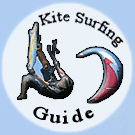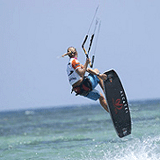Boards
Anything can be used as a board for kitesurfing: starting with water skis, and continuing with wakeboards, windsurfing boards and ending with kiteboards for offcourse. The most apropriate thing is of course , using a kiteboard. You can choose from a large variety of boards, as a lot of years have been put into designing them.
Bidirectional Boards
Generally speaking, you can say that there are two schools of thought in the kiteboards design business. The first one is based on the kitesurfers that have a wakeboarding or a snowboarding background. Bidirectional kiteboards are the ones to be used by such kitesurfers. These boards are also called twintips and are usually thin and barely floatable by itselves. They use straps or bindings in order to attach the kitesurfers' feet to the board. Although ideal for jumping and exotic moves in high wind, these boards are not good at all for less than 10 knots wind conditions. The only solution a kitesurfer has in this case is to use a big kite. The boards are between 120 cm and 180 cm long and 30 cm to 40 cm wide. When they want to jibe on these boards, kitesurfers do not have to change feet, but just reversing the direction or go from a heel down to a toe down position when engaging in such a move. This is quite similar to wakeboarding.
Bidirectional boards have led the kiteboard market for quite some time now. Most kitesurfers use bidirectional boards because of their better control while jumping and because of their ease of jibing.
Directional Boards
Kitesurfers who have a surfing or windsurfing background have created the second school of thought in kitesurfing boards' design. The boards used by the kitesurfers in this case are called directional boards. They are usually 140 cm to 230 cm long and 35 cm to 50 cm wide. The directional boards are a bit slighter than a surfing board and have sharper edges and 2 or 3 footstraps, sut like surfboards do. Kitesurfers use this kind of board when they need speed or in light wind conditions. The control over such a board is not so great given high wind conditions, because it is larger than an ordinary one. Nevertheless, they are excellent for exotic moves and jumps. When jibing on these boards, kitesurfers change feet just like in doing windsurfing.
Directional boards are not widely used in modern times. While using a directional board in light wind, kitesurfers use another type of board in high wind conditions. These are called „Mutant” and are also directional boards , but ones that have only 2 straps and the capacity to be ridden in reverse direction.
Fins and Other Accessories
Not all types of boards have fins, although fins may ease the boards capacity to go upwind. When finless, the upwind edge of the board that acts as the real fin providing lift to keep the board going upwind. The fins basically make a board keep going straight.
Most of the kitesurfing boards can easily go upwind and are suited for any person, even for beginners. If they can plan on the board , learning to go upwind is a piece of cake for them.
A kiteboard is pretty much like surfboards when it comes to the leash that attaches the board to one of the kitesurfer's feet or harness. Although an expensive , quality board type leash can successfully be used as a kiteboard leash, there have been many accidents while kitesurfing. And all of them related to board leashes! The solution some kiteboarders have come up with is that of learning "body drag upwind" to retrieve the board , without using any board leash at all.
Board Selection
Depending on the conditions of your local beach, but also on your personal likes and dislikes, you can choose between several types of boards. When choosing it, you must firstly consider the board type and size. In areas with winds over 15 knots , you should use the following tips for selecting the perfect kitesurfing board:
High wind area board selection |
Bidirectional (for most riders) |
Directional (for special reasons) |
Most Kitesurfers |
40cm shorter than your height |
|
Special Cases |
|
10cm shorter than your height |
For Learning |
20cm shorter than your height |
30 cm longer than your height |
For areas where winds are not stronger than 5 to 15 knots, consider these guidelines before going out to buy a board:
Light wind area board selection |
Bidirectional (for most riders) |
Directional (for special reasons) |
1 board |
20cm shorter than your height |
10cm longer than your height |
2 boards |
- Your height for light wind
- 40 cm shorter than your height for stronger wind
|
- 30cm longer than your height for light wind
- 10 shorter than your height for stronger wind
|
For Learning |
Your height |
30cm longer than your height |
Another important thing to keep in mind is the proportionality between the board's surface and the square root of the kitesurfer's weight, therefore a surfer who is twice as heavy as another should use a board 1.4 times the planning surface.
Board Length and Width
Older boards are longer and less wide than the ones used nowadays. In order to select the perfect width for your kitesurfing board, pay attention that the newer wide board has the same planning surface as the traditional boards, this of course, considering the fact that boards with the same planning surface should accommodate the same wind range.
The fact is that the producers make the boards wider for light wind, and up to 145 in length.
Going Upwind
Sailors move the sail backward to move the center of force behind the center of resistance of the board, fins and keel. This is the way a windsurfer uses the free sail system to go upwind.
When speaking of the kitesurfing system, a kitesurfer keeps the center of force between his two feet, by holding the kite in his hands and by transferring the pull of the kite to the board. The center of force can be modified by moving the weight from the front foot to the back foot. In order to go upwind, a kitesurfer must move the center of force, but also the center of resistance. This is how they do that:
- Kitesurfers transfer the weight more to the back foot than to the front one, so that the center of force is moved backwards.
- They press the the windward in order to put the board from 15 to 45 degrees to the water, thus moving the center of resistance forwards.
To sum it up, the kitesurfers „ride” on the board's windward edge so that they can go upwind. Theoretically speaking, given the fact that the center of resistance of the board is between the kitesurfer's feet, he can go downwind by transferring his weight to his front foot and he can also go upwind by moving the weight to his backfoot.


